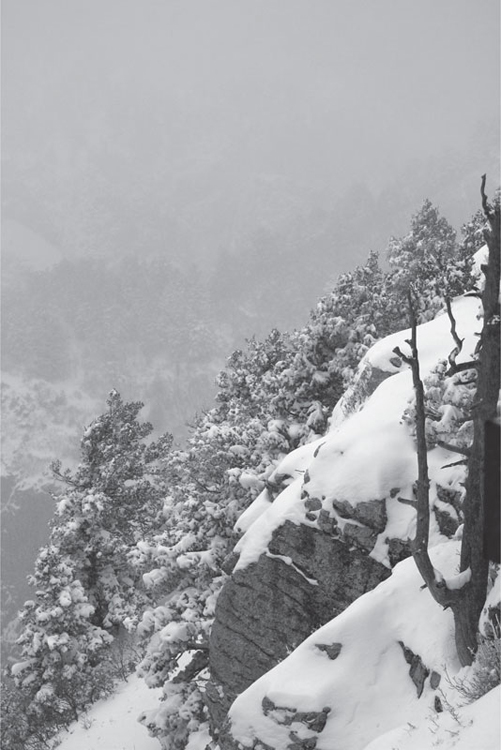
Views from the Sandia Tramway are spectacular. You will pass tall rock formations and towering pine trees on your 2.7-mile journey up the mountain. Courtesy of the author.
1
ALBUQUERQUE
HISTORIC ALBUQUERQUE
Officially founded in 1706 as a Spanish presidio, Albuquerque was originally a settlement formed on the banks of the Rio Grande by the ancient Tewa people, who inhabited early pueblos and have been recorded in the area for at least twelve thousand years. Evidence of these peoples has been found in the form of projectile points, adobe structures and petroglyphs, as well as other artifacts housed in the many museums in the modern city.
The Spanish conquistadors made an appearance in 1540 with the expedition of Francisco Vásquez de Coronado as they explored what is now New Mexico for gold and other riches. They found well-structured Puebloan farming communities. Within a few months of discovering these communities, the Spaniards forced the residents out and commandeered the structures and supplies for themselves, causing deep strife with the native people. Coronado would leave in 1542; following a fifty-six-year gap, in 1598, the next Spanish explorer, Don Juan de Oñate, showed up on their land to create more havoc.
Tired of being enslaved by the Spaniards, the Puebloan people rioted against their oppressors in the Revolt of 1680. Many Spaniards were killed as the Tewa people attempted to wipe out all evidence of the Spanish culture at their pueblo structures and surrounding lands. The Spaniards fled south to the Mesilla Valley, where they stayed for many decades until they finally braved the northern lands again.
Albuquerque started humbly and grew due to the railroad. It is through the railroad that many of its first residents came to the once desolate region. Railroad workers, businessmen and ladies of the night soon flocked to the tiny town in search of work. The red-light district flourished, which gave fits to the residents who fought hard to wipe this type of influence out of the town. Prohibition in the 1920s would do their job for them, and the district faded into history. The town expanded rapidly as construction began to radiate out from the Old Town area, where a few famous lawmen and outlaws could be still seen strolling the streets.
Early Albuquerque started out without a good zoning plan, so you will notice mansions across the street from hovels and a business in the middle of the residential area. This lent charm to the Albuquerque we know today.
ALBUQUERQUE TODAY
As New Mexico’s largest city, Albuquerque is continually growing and expanding its boundaries. New subdivisions are being built almost daily as the consumer base strengthens. Home to huge industries and mom-and-pop businesses, Albuquerque has everything a person could want within the small subcommunities contained within the larger shell.
Old Town is a history buff ’s dream: a ten-block grouping of historical buildings erected around a central plaza. Included among these buildings is the oldest, San Felipe de Neri Church, which was built in 1793. Surrounding the church are adobe structures that were at one time private residences— now art galleries, restaurants and shops. The Plaza plays host to fiestas, parades and pageants. One quirky part of Old Town is the eighteen-mile-per-hour speed limit. Yes, you read that right—eighteen. The speed limit was originally installed because of Bicycle Boulevard in an effort to get drivers’ attention to slow down for the bikes. There is also a scenic train ride available for your pleasure, and plans to include a trolley system much like the one used in the 1870s are said to be in the works.
The Albuquerque Bio Park and Aquarium/Zoo is located near Old Town as well. It gives visitors a full day’s worth of activities, as does the Rio Grande Nature Center and Wildlife Refuge. The Bosque, named after the Spanish word for woodlands, runs along both sides of the Rio Grande, which divides East and West Albuquerque. This unique area provides residents and visitors with a multiuse area for biking, hiking, skating, horseback riding and running.

Views from the Sandia Tramway are spectacular. You will pass tall rock formations and towering pine trees on your 2.7-mile journey up the mountain. Courtesy of the author.
The Bosque is a protected area, the goal being to maintain its wilderness qualities as one of the world’s largest cottonwood forests.
You always know you are traveling east in Albuquerque when the Sandia Mountains (Spanish for “watermelon”) are in front of you. This gorgeous mountain range glows a pinkish red at sunset, hence the name. The Sandia Peak Tramway travels up this mountain range, giving visitors some of the best views in New Mexico. The tram travels 2.7 miles over deep canyons, climbing 10,378 feet to the top of Sandia Peak, and it is suggested that visitors try to time their trip to catch one of New Mexico’s legendary sunsets. The tramway is open all year, closed only in high-wind situations. There is an eclectic gift shop at the bottom, and the trams are wheelchair accessible. A restaurant is slated to open soon at the top of Sandia Peak that will provide spectacular views to the lucky diners.
The Sandia Peak Tramway is the legacy of balloonist Ben Abruzzo, along with help from business partner Bob Nordhaus. It was built in 1966. The industrious pair also had a hand in starting Ski Santa Fe in 1984. Daredevils and ski enthusiasts, the partners were well known to skiers in the area. Members of Abruzzo’s family are now real estate developers in the Albuquerque area.
Every October, thousands of visitors come to Albuquerque to witness a spectacular site: the International Balloon Fiesta, which began in 1972. Hundreds of brightly colored balloons, many with special shapes, take to the sky each morning of the fiesta after they get the “all clear” from the weather station. The beautiful azure skies are filled with bubbles of color as the balloons drift slowly over the city skyline in the brisk morning air. A crowd favorite is the Special Shapes Rodeo. To name just a few balloon shapes, there are motorcycles, stagecoaches, bumblebees, Star Wars characters, turtles, ducks, saguaro cacti, zebras, cows, suns, bulldogs and jesters. And yes, you will even see a pig fly! This is an event not to be missed.
West of the city proper lies the Petroglyph National Monument. It contains thousands of ancient petroglyphs carved into the basalt boulders and cliffs by the Puebloan people. This popular hiking area is easily accessible from a major road that separates the monument from nearby neighborhoods.
For nostalgic visitors, Albuquerque is a celebrated stop along the Mother Road, Route 66, which brought hordes of visitors into the city while introducing them to the Land of Enchantment. Historic hotels, with their eye-catching neon signs, lined the route along what is today Central Avenue. Several of the vintage hotels, like the Aztec Motel (the oldest), the El Vado Motel (built in 1937), the Tewa Motel, De Anza Motel, Luna Lodge and the Town Lodge Motel, still exist. Some are being renovated, so the area will be getting a much-needed renewal.
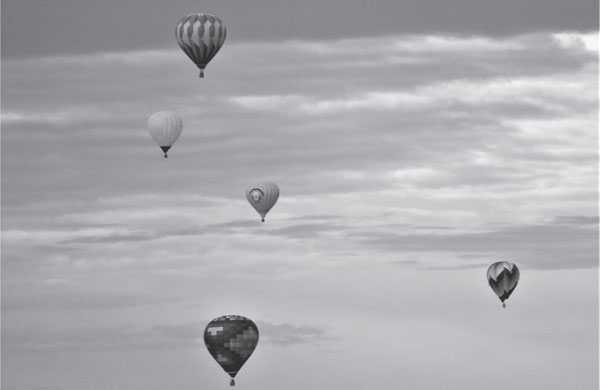
Hundreds of brightly hued and special-shaped balloons dot the morning skies as they participate in the International Balloon Fiesta, held the first week of October. Courtesy of the author.
At the height of Route 66 in 1955, there were more than one hundred hotels along Central Avenue. It is said that travelers would have a tough time finding an available room. Today, Central Avenue is an eclectic mix of cultures and styles. The University of New Mexico is located on Central Avenue, so there are many coffee shops, pizza parlors, bike shops and unique eateries catering to students. There is a bohemian feel along the Avenue that ushered in the New Age movement with specialty shops, bookstores and yoga centers. It’s also a great spot for thrift store shopping; you’ll never know what treasures can be found.
As with the state itself, many cultures call Albuquerque home. This brings an eclectic blend of diversity for everyone to experience. The University of New Mexico is the hub of the Nob Hill area, which offers a wide variety of kitschy shops that appeal to the young residents and the young at heart. Restaurants of every description dot Central Avenue, some of which have been featured on Guy Fieri’s Food Network show Diners, Drive-Ins and Dives. The Frontier Restaurant, across the street from the university, is a must-see, if only to try one of its world-famous cinnamon rolls.
THE PAINTED LADY BED & BREW
Located approximately one mile from Old Town, the Painted Lady Bed & Brew holds a good amount of history within its walls. A former brothel, grocery store and saloon, the Painted Lady could certainly tell some sordid tales. Restored and remodeled by owner Jesse Herron, cofounder of the Albuquerque Tourism & Sightseeing Factory that includes ABQ Trolley Co., Albucreepy Downtown Ghost Walk, and Duke City Pedaler, the Lady still has an air of mystery about it.
Taking up the better part of half a city block, the 135-year-old Painted Lady proudly stands its ground with native landscaping and private fencing. Owner Herron was described by the Albuquerque Journal as “one of the city’s most prolific tourism entrepreneurs,” and the Painted Lady Bed & Brew is a first of its kind. Albuquerque has seen an explosion of craft breweries in recent years, and Herron wants to capitalize on this by offering guests selections of local beer, “served in small quantities under a special bed and breakfast state liquor license.” The Lady is also within walking distance of six taprooms and breweries.
Thought to have been built in 1881, the property was, as Herron put it, “a hidden gem” when he purchased it on February 3, 2014. He spent two years remodeling the site. A next-door neighbor found a signed board on his property dated December 12, 1897, which gives validity to the timeframe of when the Painted Lady was also built. It is also rumored that New Mexico’s favorite boy outlaw, Billy the Kid, and the man who would eventually do him in, Pat Garrett, stayed there while in pursuit of the Kid, on separate dates, when it was a hotel before the Kid’s death on July 14, 1881. Hotel registers are thought to exist that verify this fact.
Charlie’s Grocery Store is owned and operated by Charlie Gonzales, who was the grandson of the original owner, Cesario Gonzales. The store and some low-income apartments once dominated the corner of Bellamah and Twelfth Streets. It is now part of the Painted Lady Bed & Brew property. Former owners also told Jesse that the site of the Painted Lady was once Native American land and was part of the Battle of Albuquerque, which took place near Old Town from about Fourth Street to the Rio Grande. There may be burials in the area. Herron had once considered tearing down the property when he purchased it, but the history fascinated him too much. Two years of lovingly remodeling the abodes resulted in a unique bed and brew for Albuquerque.
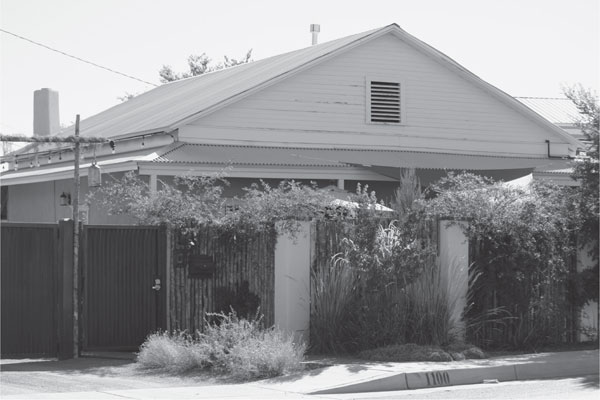
Although this old girl has seen a colorful life as a saloon and brothel, the Painted Lady offers solitude in the heart of the busy city. Courtesy of the author.
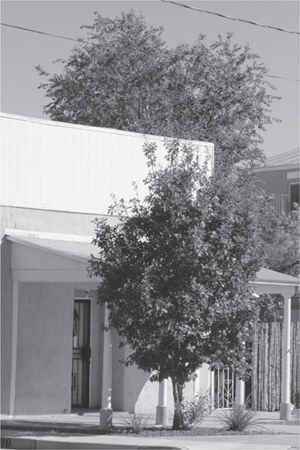
Painted Lady Bed & Brew near Old Town Albuquerque is within walking distance of many fine breweries in the neighborhood. Courtesy of the author.
In a 2016 article for the Albuquerque Journal stating his reasons for opening his business in such a remote part of town, Herron states, “They want to be in somebody’s home or a neighborhood where there’s real culture, and not paying for parking or Wi-Fi or sharing the wall with somebody else. I think that’s kind of where the trend is going.”
When the Painted Lady was an eight-room brothel, it was conveniently located across the street from the American Lumber Company, which employed a lot of men. Each of the eleven-by-eleven-foot rooms had a window and a door that the ladies of the house would leave open to lure customers. There were a total of fourteen outer doors. A movable sign in front of the building was used to indicate a bar in the daylight hours and a brothel in the evening. The family that owned the establishment kept its business on the sly, and it is not mentioned in many of the newspaper articles written about the red-light district in the late 1880s and early 1900s, except for a brutal stabbing that took place in 1904 that sent four patrons to the jail and the hospital. Early newspaper articles were not clear as to the direct cause of the fracas, but when alcohol and women are involved, one can only imagine.
The connected bar was called the Swastika Saloon, for which the clientele developed a special drinking song. The former owners were bootleggers and moonshiners who made thousands of dollars in their trade. Since they did not trust banks, they would bury their money in coffee cans on the property. Jesse states that most of the money has already been recovered—but not by him!
The Swastika Saloon drinking song was originally written as follows:
When you heels hit hard and
Your head feel queer,
And your thoughts rise up like
The foam on a beer,
When your knees are weak and
Your voice is strong,
And you laugh like the devil at
Some d--- fool song,
Yer drunk, old boy, yer drunk
When you wake up in the morning and
You feel all in,
With a bursting head that aches like sin,
You feel in your pockets
Void of tin,
You’ll probably say,
What a d--- fool I’ve been.
Yer sober, by gosh, yer sober.
Jesse has been busy expanding his enterprise. He has purchased one of the original trolleys that was used in Old Town Albuquerque and that still had the old spelling of “Alburquerque” painted on the side. His plans include moving the trolley onto his property and turning the relic into “sort of a tap room for bed and brew guests.” He has also purchased the old 1910 casita next door (a former bakery) and has plans to renovate this as well, to be used as part of the Painted Lady Bed & Brew.
The Painted Lady is open for business as of April 7, 2018, which is also National Beer Day, Jesse feels he will be able to bring even more of the authentic New Mexico to his guests. Guests will be able to enjoy the locally brewed beers, as they will be given a couple of pints when they stay.
Jesse is extremely proud to be able to embrace the enormous history of his property while bringing new life to the buildings. The otherworldly guests are just a bonus to the all-around atmosphere.
GHOSTS
The owner’s suite is the most haunted room of the house, and Jesse has experienced a variety of ghostly visits, from the comical to the hair-raising. The old owners described this room as “haunted as hell.”
One story of a particularly menacing spirit will be sure to give you goose bumps. The legend states that a man found his wife with another man in the hotel and returned with an axe and proceeded to hack the couple to death. The spirit of the hacked man was still present when Jesse purchased the house. This room is said to be particularly disturbing to women, who are more sensitive; many of the former owners would not enter.
Also during this time, it seems everything was going wrong. There were problems with the renovations and the contractor—nothing was going smoothly. So, to stop what Jesse describes as a nightmare, he called in someone whom he describes as a kind of Buddhist priestess, who performed a cleanse on the home. She stated that there were three spirits in permanent residence in his apartment area of the home. The most menacing of them liked the corner and did not want to leave.
Although Jesse thought he had come to an understanding with the apparition (“leave me alone and I’ll leave you alone”), he soon found out that the spirit wasn’t going to live up to his side of the bargain and began to torment Jesse’s three-legged dog, Bill Murray (Murray for short). This was too much as the dog was older and would yelp in pain and present bloody marks from apparently being bitten by something unseen.
Jesse called in a couple of local mediums who set up a demon trap for the spirit they identified as “Bill.” Bill was described as in his forties, nicely dressed in the style of the late 1880s. The spirit did not leave quietly. but was eventually banished from the home. Jesse’s dog, Murray, was immediately happy. Not to worry, Jesse assures that Bill is gone.
During renovations, Jesse’s mother helped with the decorating. As they were preparing for guests, who were arriving later that day to go to the International Balloon Fiesta, his mother was taking the plastic off the brand-new refrigerator. She asked Jesse what he had said to her, to which he replied, “I haven’t said anything.” His mother laughed, reporting that she had heard a man ask her, “Can you grab me a beer?”
Another medium told Jesse that there is a ghost dog present in the home, which Murray has noticed. The ghost dog upsets Murray when the spirit messes with his food bowl.
On numerous occasions, Jesse has been, as he states, lucky enough to hear two men talking, an old piano playing, glasses clinking and sounds of the barstools dragging on the floor, no doubt residual sounds of the brothel.
A family member of the original builders told Jesse and his family that there are three ghosts who reside in the property. But, they were quick to say, they were “nice” ghosts. Jesse was told to expect to hear at approximately 12:30 a.m. each morning a “shuffle, shuffle, cane, jiggle.” This is Uncle Charlie doing his nightly check of the doors to keep his guests safe.
RED HORSE VINEYARD BED & BREAKFAST
Nestled in the farmlands of the South Valley of Albuquerque, the Red Horse Vineyard Bed & Breakfast is a little piece of heaven. The moment you step on the property, you begin to take deeper breaths and look for the nearest easy chair to bask in the serene surroundings. At the Red Horse, they like to say that the time spent there is an experience—not just a stay. Guests have been quoted calling the Red Horse an “oasis in the desert.”
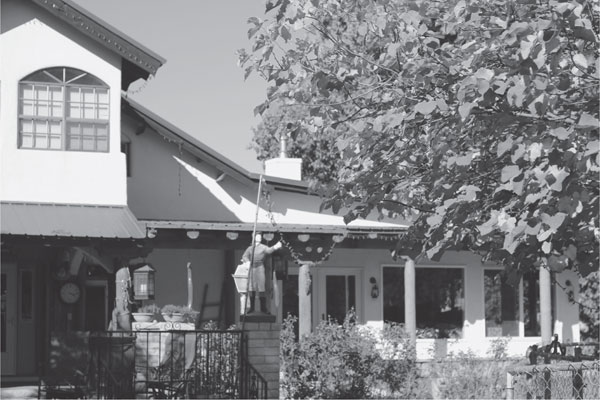
The red trim on the white house of the Red Horse Vineyard Bed & Breakfast is a tribute to Carl Londene’s Swedish heritage. Courtesy of the author.
Built in 1870, the site was purchased by the Londene family in 1968, even though the structures on the property were in extreme disrepair. This was the only house in the area when the Londenes bought the property. The vineyard located on the front of the property dates to 1892 and had to be lovingly tended to produce the grapes the family uses in their wines. These precious grapes were brought to the New World from Europe when the Ellis family homesteaded the area in the 1870s.
A root cellar is now the wine cellar, filled with rare wine-processing equipment, such as a 1914 wooden grape press (the only one in New Mexico), which is still used today. This equipment is museum quality; in fact, the Londenes have been approached many times with offers to purchase the treasures, but all have been refused.
Carl Londene started making his own wine in 1969 and still has a few of his first run in the wine cellar. The first winery on the property was started by the Ellis family in 1912. Wine and apple cider have been produced on the Red Horse property since 1870, except for the twenty years when the second owners, the Winfields, owned it. The original grapes in the vineyard remain unidentified, but there are Concord and Cabernet Franc, which were used to supply mission wine to the area. There is still one white grape in the vineyard, which no one has been able to identify yet. It is the last to mature in September and is so sweet that no sugar is necessary to add to the wine.
In its lifetime, this property has been part of the Artrisco Land Grant (one of the few Spanish colonial land grants still in existence today), was a Neosho Pony Express turnaround station, had wagon train mule exchange corrals and was a campsite for the Confederate army during the short-lived Civil War Battle of Albuquerque.
During the Battle of Albuquerque, it is said that a cannon located on the Red Horse property in the Civil War era was fired from there to Old Town, some five miles away. The battle began on April 8, 1862, when rival forces led by Edward R.S. Canby of the Union army and General Henry Hopkins Sibley of the Confederate Texas Mounted Volunteers lobbed long-range artillery at each other for two days. The Confederates were on the retreat from the Battle of Glorieta Pass and occupied Albuquerque during this movement. The battle stopped when Canby was informed by a resident that the Confederates would not let the citizens take shelter.
Canby decided that his army had made its point and caused other Confederate factions to leave their posts to come to the aid of Sibley’s forces; he left under the cover of darkness without being detected. Sibley ceased his occupation of Albuquerque on April 12, 1862, leaving behind his wounded and is said to have buried eight mountain howitzers and several cannons on the edge of town before retreating farther to Texas.
The remnants of the original wood and tar paper house finally collapsed in 1971, but the Londenes salvaged the wood from the structure and repurposed it throughout the property. There is an eight-foot-deep fish pond in the front yard of the Red Horse that was once the original wine cellar.
Another interesting building on the acreage is one of the three original adobe structures that once housed the braceros (Mexican farmworkers). This building had five rooms housing five to six people per room. Each room contained only one bed and a woodstove. The braceros were vital to the agriculture system of the region until a fire swept down the acequia (irrigation ditch) that connected all the farms and burned up the valley. The braceros were no longer needed in the valley, so they moved on.
The Red Horse Vineyard Bed & Breakfast is family run and operated. On most days, you will see the dynamic team of owner Carl Londene and his daughter Darlene and son-in-law Phil Capshaw working on some aspect of the B&B. Accomplished artists, father and daughter create beautiful works in ceramics as well as oil paintings. The ceramics, inspired by the owner’s Swedish heritage, feature the red Dalecarlian horse, which originated in Dalarna, Sweden, hence the name Red Horse. The wooden carved horse was originally used as a toy for the children of the villages but later became a source of livelihood for the wood-carvers who began the tradition.
Upstairs guest rooms have original wood paneling, and the downstairs has the original wooden floors. Although a recent addition, the game room makes use of the earliest windows from the collapsed structure. This way, the Londenes feel they are carrying on the traditions of the land and carrying it forward for the new generations. Each of the rooms and the hallways are graced by paintings done by Carl Londene as well as murals created by artist and family friend Sharon Higgins. Darlene reported she was honored to be asked by Sharon to paint the train in a mural in the bathroom depicting five generations of the Londene family.
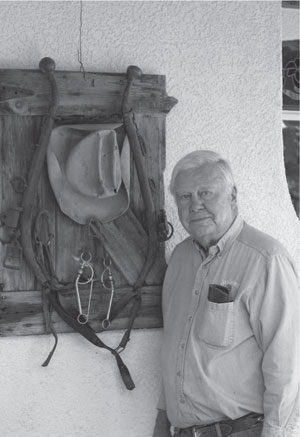
Hand-painted ceramic items are available for purchase at the Red Horse Vineyard Bed & Breakfast. Carl Londene creates vignettes from old tools and found items. Courtesy of the author.
A gift shop in the main part of the house contains a wide variety of their handiworks, including coffee mugs, bells, necklaces and earrings, gnomes and, of course, red horse figurines. The rooms of the bed-and-breakfast are adorned with many of Carl Londene’s original paintings, setting the mood and theme for each room. As a rancher, Londene used many tools in his trade, and many of these artifacts have found their way into interesting vignettes created by the owner. Hats, chaps, lariats and spurs grace the quaint artwork.
Peaceful surroundings and grounds make the Red Horse a perfect venue for weddings, reunions, birthday celebrations and weekend retreats. You will feel instantly at home and welcome.
Mr. Londene’s sense of humor is a delight, and the pride he has for the legacy he and his wife, Donna, have established is evident in his twinkling eyes. Although there is a huge hole triggered by Donna’s passing in 2013, her welcoming spirit is still quite apparent in her loving family.
GHOSTS
Carl Londene’s late wife, Donna, was a sensitive and could feel the presence of the otherworldly. She would carry on conversations with beings no one else was able to see. This was quite normal for Donna, and it didn’t bother her a bit. But for others, it was unsettling.
Two little girls in blue were some of Donna’s favorite visitors. The girls would skip up and down the upstairs hallway, giggling as they played. Recent visitors to the Red Horse asked Darlene where the children were that were playing in the hallway. Much to their surprise, there were no children on the property at that time.
Another of the frequent spirits was a man dressed in Victorian clothing who would appear at the foot of Donna’s bed from time to time. The two would carry on extensive conversations.